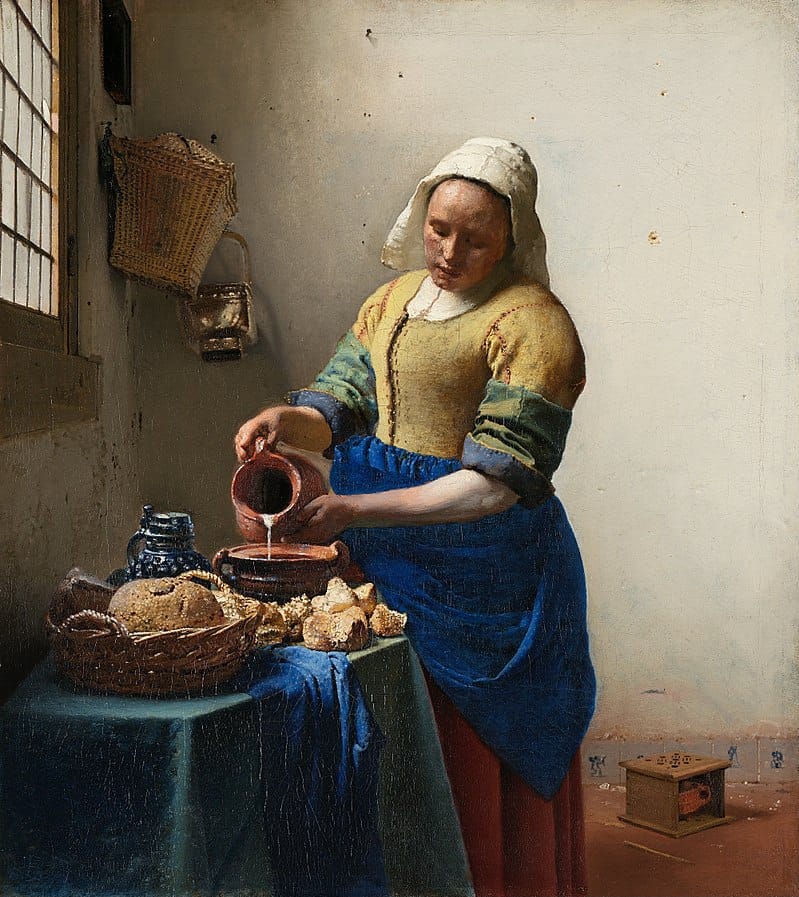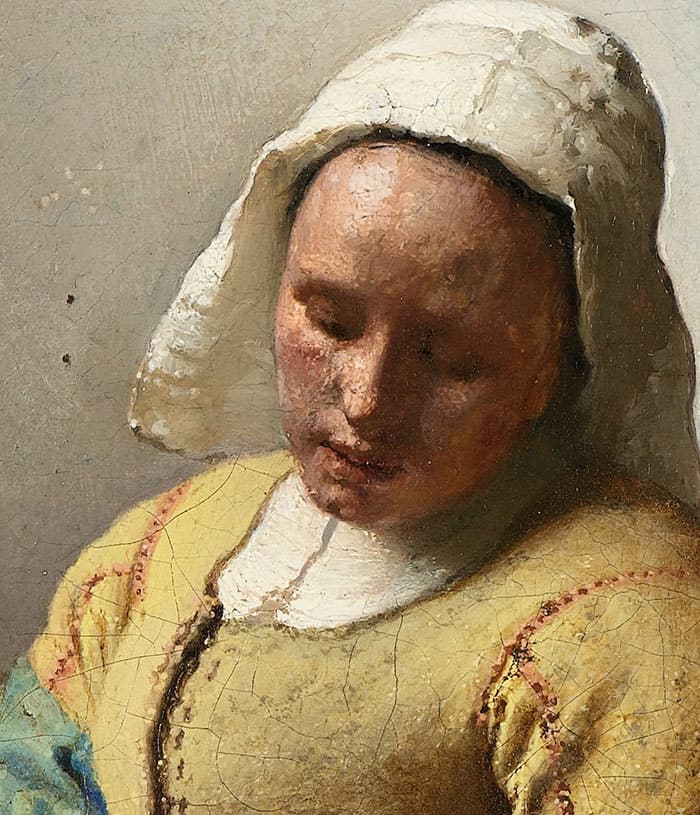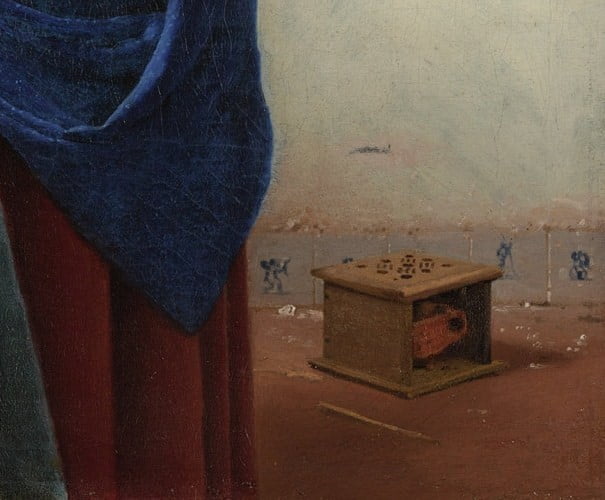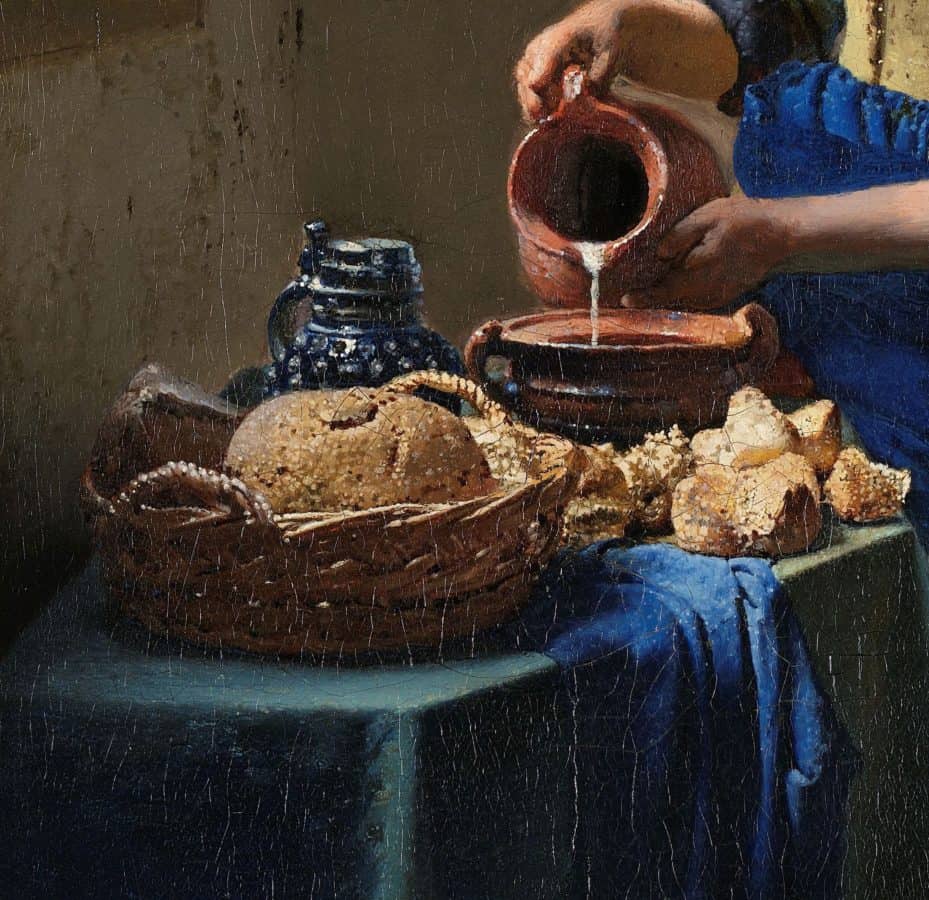It’s arguably one of the most famous paintings depicting a historical domestic scene, and in this post, you’ll discover the ultimate list of facts about The Milkmaid by Johannes Vermeer, one of his most famous works!
1. It depicts an ordinary scene of a milkmaid
The Milkmaid by Johannes Vermeer is referred to in Dutch as “De Melkmeid” or “Het Melkmeisje.” This refers to the occupation of the girl depicted in the painting who is doing her daily chores while working with dairy products like milk, butter, and cheese.
We can see her carefully pouring milk into a container while she is clearly concentrated on the job. This realistic scene resembles very much the painting of “The Lacemaker” by Vermeer, the painting of a girl who is glancing down as well as she is focusing on the task at hand.

2. It’s unclear when the painting was completed
One of the most remarkable facts about The Milkmaid by Johannes Vermeer is that it’s unclear when the artist completed this painting. Sources state that it was completed anywhere between 1657 and 1661.
As Vermeer was born in the year 1632, this means that he was between 25 and 29 years old when he finished this masterpiece. It has therefore been described as either the final work of the first phase in his career or the first work of his maturity.

3. It’s a relatively small painting
Vermeer wasn’t the artist who created enormous paintings but rather a man who created small and delicate paintings with an extreme eye for detail.
This work isn’t any different as it’s a relatively small painting with dimensions of 45.5 x 41 centimeters (17.91 × 16.14 inches). This is about the same size as another one of his masterpieces called “Girl with a Pearl Earring” (1665) and about 1/3 the size of one of his largest paintings called “The Art of Painting” (1666-1668).
4. The painting has been described as “Vermeer’s Mona Lisa”
What makes this painting so interesting is the fact that the girl has a sense of mystery about her. She’s looking down as she is pouring milk and we can’t really see the expression on her face. This evokes an instant reaction for the viewer to question what she is thinking about.
Some have described this as the “Mona Lisa effect,” referring to da Vinci’s ultimate masterpiece which equally leaves us dazzled with a sense of awe and mystery.

5. The woman in the painting wasn’t merely a milkmaid
Even though the painting’s title refers to the girl as a milkmaid, she was probably much more than that. A more accurate term to describe the girl would be a “kitchen maid” as she had most probably a lot more tasks in her daily routine than what we see her doing in this painting.
Milkmaids specifically were women who milked the cows and wouldn’t have worked in the kitchen at the time this painting was created. Because of this, we can conclude that the title refers to the milk she is pouring and not her overall job description.
6. Maids weren’t usually depicted the way Vermeer did in the 17th century
One of the most fascinating facts about The Milkmaid by Johannes Vermeer is that paintings about household workers usually had a sexual connotation to them. Maids were considered to be objects of lust so they were often portrayed along with suggestive elements.
Vermeer didn’t depict the girl in such a way and merely depicts her as she is doing her daily job in a dignified manner, something very unusual for this time period.

7. There’s a footwarmer on the floor behind the woman
If we dig a little deeper and take a closer look at the details in the painting, we can see that there’s a footwarmer on the floor behind the woman. This could be considered as a suggestive element, but the fact that footwarmers were used while sitting down probably emphasizes the hardworking nature of the maid.
Behind the footwarmer, there are distinctive Delft tiles and one of them depicts Cupid. This might be an element referring to the fact that the woman is daydreaming about her lover while doing her job.

8. The milkmaid is making a bread-based desert
So what is the girl preparing here?
We can see pieces of bread scattered all around the table and she is clearly carefully pouring milk into the container. There was most probably already bread mixed with eggs inside the container so she carefully measures how much milk she needs to pour.
The result of this preparation technique was most probably a delicious bread pudding!

9. Vermeer removed two elements he originally included in the painting
The vantage point of the painting is relatively low and two diagonal lines can be drawn which come together at the woman’s right wrist.
One of the most fascinating facts about The Milkmaid by Johannes Vermeer is that the artist overpainted two elements he originally included in the work. These were a large wall map hanging on the wall behind the woman and a clothes basket which was located at the bottom of the painting.
This further indicates that Vermeer wanted the focus of the painting to be on the task that the girl was performing rather than other distractions.
10. The colors used differentiate it from other contemporary works
Even though Vermeer achieved relative success as a local painter during his lifetime, he was in serious debt the moment he passed away. His financial difficulties didn’t hold him back from using expensive painting materials though, even though art historians have suggested that these were donated to him by the people ordering his paintings.
In this painting, he used the very expensive natural ultramarine instead of the more common and much cheaper azurite. The other dominant color used in the painting was lead-tin-yellow, a pigment that allowed Vermeer to do his magic with the light coming into the room from the left.

11. It was Vermeer’s second-most expensive painting in the late 17th century
The painting changed hands multiple times shortly after Vermeer passed away in the late 17th century. It was officially sold in an auction in the year 1696 along with multiple other of his most famous works.
It ended up being sold for 175 guilders which was the second-highest price of any of his paintings. Only “View of Delft,” the cityscape of his hometown, sold for 200 guilders.
12. The Milkmaid has traveled quite a bit the past centuries
So where can we admire The Milkmaid today?
It ended up in a private collection in the 18th and 19th centuries. Because it was feared that the painting was going to be sold to a rich American collector in the early 20th century, the Dutch government decided to buy the painting so it could be put on display at the “Rijksmuseum in Amsterdam,” where you can admire the painting today.
It has been on display all over the world, though, including during the 1939 World’s Fair in New York City after which it got an extended stay in the United States until the end of World War II.
It has also been displayed in exhibitions all across Europe, including London, Paris, Rome, and Milan!



